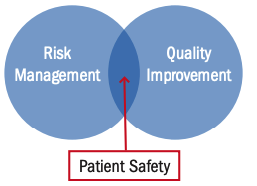The Link between Risk Management, Patient Safety, and Quality Improvement
Overview of Issue
Risk managers leverage the links between risk management, patient safety, and quality improvement. Threats to patient safety are a key element of a broad array of risks that healthcare organizations need to consider. Quality improvement focuses on achieving best possible outcomes; this can be achieved through examining and managing risks to the healthcare organization. By fostering a culture where healthcare providers are empowered to speak up, risk managers can use incident reports and other sources of information to manage risk, influence key decision makers, and ultimately impact patient safety and quality care.
Key Points
- In order to manage risk, one must consider multiple sources of information including patient safety and quality data.
Things to Consider
How patient safety overlaps with risk management
- The risks to a healthcare organization’s objectives reflect a broad array of objectives including healing (and not harming) patients; maintaining a safe environment for staff; being fiscally responsible; maintaining or adding services; meeting applicable standards and regulations; and maintaining a favourable public reputation.
- Patient safety focuses in mitigating harm to patients; risk management focuses on patient harm as a key priority as well as other types of risks.
- In HIROC’s taxonomy of healthcare organizational risks, patient care is one element of healthcare risk that an organization must address. Examples of adverse events that impact patient safety while also posing risk to healthcare organizations are: birth trauma; diagnostic errors; falls; pressure ulcers; and suicide.
- The role of risk managers has changed over time. Historically, risk managers had a reactive role in responding to incidents whereas the evolution of the patient safety movement encouraged proactively looking at risk and using a systems approach to understand error.
- Patient safety is influenced through an organization’s efforts to enhance healthcare provider safety.
How quality improvement overlaps with risk
- There are six dimensions of healthcare quality: safe, effective, person-centred, timely, efficient, and equitable. Safe refers to avoiding harm to patients from care that is intended to help them and means that no needless deaths occur.
- Quality managers focus on achieving best possible outcomes in patient care; assure the healthcare organization meets accreditation and other regulatory requirements; report outcome data in an accurate and timely fashion in alignment with decision support; and improve processes leading to instances of suboptimal care or errors. As with patient safety, HIROC’s taxonomy of healthcare organizational risks addresses elements of healthcare risk that are addressed through quality improvement (e.g. accreditation, learnings from adverse events).
Risk management, patient safety, and quality improvement
- Risk and quality functions in a healthcare organization overlap in patient safety. Examples include analysis of patient safety and critical incidents; production of Board reports; building a culture of safety; handling of patient complaints; proactively assessing risk; public reporting of quality data; and incident reporting analysis.

Sources of information used by the risk manager
- Risk managers review information from a variety of sources in order to manage risk. These sources include: patient complaints; incident reports; quality of care review recommendations; never events; claims; medical record requests; recalls/ alerts; coroner recommendations; accreditation recommendations/performance; publicly reported patient safety indicators; new legislation; the healthcare organization’s strategic plan; safety culture survey results; and reports from executive walkarounds.
- When healthcare providers feel empowered to speak up issues and problems can be identified and addressed. The risk manager’s role supports reporting incidents and aggregating information to identify potential areas for improvement.
- The learnings from healthcare claims provide a source of information that risk managers can utilize to improve patient safety. Healthcare organizations can prioritize areas of focus based on trends in claims data.
References
- HIROC. (2017). The link between risk management and patient safety [PowerPoint].
- ASHRM. (2007). Different roles, same goal: Risk and quality management partnering for patient safety.
- ECRI. (2014). Patient safety, risk, and quality. Healthcare Risk Control, 2.
- Leviton J, Valentine J. (2015). How risk management and patient safety intersect: Strategies to help make it happen.
- Napier J, Youngberg B. (2011). Risk management and patient safety: The synergy and the tension. In B. Youngberg (Ed.), Principles of Risk Management and Patient Safety: 3-11.
- Health Quality Ontario. (2015).Quality matters: Realizing excellent care for all.